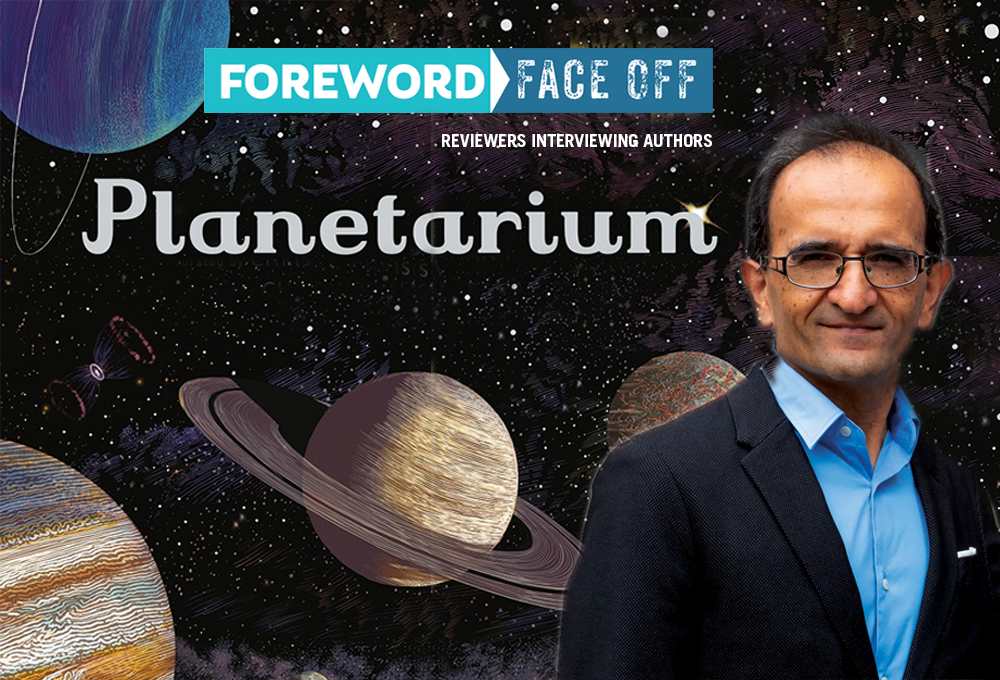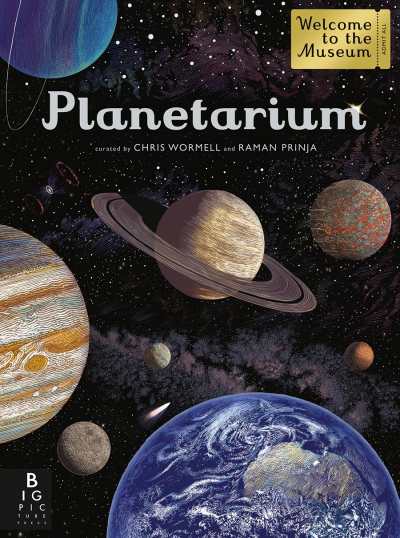Reviewer Pallas McCorquodale Interviews Raman Prinja, Author of Planetarium: Welcome to the Museum

The universe is giving up her secrets, slowly but surely, and we’re learning some fascinating stuff about what happens when black holes crash into each other, organic matter on Mars, a zombie star that seems to come back to life after dying, stars that formed just 180 million years after the Big Bang, and even a big galaxy that doesn’t seem to have any dark matter.
All these recent discoveries are being made by scientists using ever better technology. And advancing technology is exactly what we can look forward to in the future, as long as youngsters continue to grow up dreaming about the stars and distant planets.

We can thank Raman Prinja for doing his part to inspire future astronomers. Raman teamed up with illustrator Chris Wormell and Big Picture Books to publish Planetarium: Welcome to the Museum, a splendid new children’s book Pallas McCorquodale gave a starred review in the July/August issue of Foreword.
Well, you know the routine: we put reviewer and author together, and as she is wont to do, Pallas leaned on her space-crazy young library students for help penning a few interesting questions.
Enjoy the interview!
I liked reading about black holes the most and imagining what they look like. Was there anything that you liked writing about the most?
—Olivia, age 7
Planetarium covers a lots of different topics about space, but I did especially enjoy writing about the most bizarre ones. These included not only black holes, but also exploding stars, galaxies smashing into each other, and incredible planets orbiting around other stars.
My favorite page is the life cycle of stars. Each stage is prettier than the last. Do you think the pictures are pretty, too?
—Anabelle, age 7
Yes, I totally agree, the story about the birth, life, and death of stars is really amazing. Each main stage of this life cycle has beautiful objects, such as the nebulae in which stars are born and when very old stars puff away their outer layers into space.
Have you always been interested in space? Have you visited many planetariums?
—Donald, age 11
Space has fascinated me ever since my parents bought me my first telescope when I was 12 years old. When you live in a big city like London (as I do), the bright lights of buildings and streets at night can make stars in the sky hard to spot. So I too went to planetariums, to experience more about the night sky and the fainter objects. In the end, however, I still much prefer trying to find a safe, dark site and explore the wonders of the night sky for myself!
My school went to NASA on a field trip. Imagining going into outer space is scary. Would you go if you could?
—Bryce, age 7
I would love to go into space and experience the sights enjoyed by astronauts! It would be amazing to not only look at stars with my own eyes from well above our atmosphere, but also back at the whole planet Earth.
I didn’t know any of this before! Did you study space in school?
—Ryan, age 6
The great thing about the universe is there are so many amazing things to discover. We only had a few lessons on space when I was at school, but I really got properly into the subject when I went to university. Never stop exploring and discovering, Ryan!
I love Planetarium‘s museum style format which is divided into themed galleries, each addressing a facet from “The Solar System” and “The Night Sky” to “Galaxies” and “The Universe.” There is quite a bit of information here, and while I enjoyed Ryan’s extreme enthusiasm and immediate conclusion that you must have studied very hard at school, I was secretly agreeing with him. Did you research any topics specifically for Planetarium or is this all general knowledge for astrophysicists? How did you choose which topics to focus on?
I wanted to provide an overview of the whole universe, and so Planetarium gives readers a tour or walk through a wide range of topics that span increasing sizes and distance scales, from planets to galaxies. I have over the years built up knowledge over all these topics, and it was great to share some ideas with the young readers.
Sharing this book with younger children, it was easy to pick out fun facts throughout which really kept the reading fresh and interesting. For example, “Northern Hemisphere Constellations” includes a list of alternative names for the Big Dipper—from the Plough in the UK to France’s saucepan or the ancient Mayan parrot. This always gets a big reaction, but there is definitely an appeal for older children and adults, as well. Were you writing with a particular audience in mind?
In Planetarium, I particularly wanted to share the awe and excitement of space with the young readers. There are some fantastic discoveries being made right now, such as about supermassive black holes and water worlds orbiting around others stars, and I very much hope that Planetarium will help inspire the next generation of universe explorers. Meanwhile, it’s great that teachers and parents might also pick up Planetarium so that they can try to keep up with the kids!
The illustrations use a form of traditional wood engraving and linocut done by Chris Wormell, and the result is a beautiful, almost antique finish. What are your thoughts on this collaboration?
It has been wonderful working with Chris Wormell on this book. His fantastic illustrations give Planetarium a beautiful and unique look, I think. We wanted the readers to have the feel of wandering and exploring through an old-style museum that was packed with 21st century space discoveries!
Pallas McCorquodale
